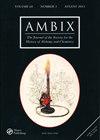A Rainbow Palate: How Chemical Dyes Changed the West’s Relationship With Food
IF 0.3
3区 哲学
Q3 HISTORY & PHILOSOPHY OF SCIENCE
引用次数: 3
Abstract
Garraf landfill, where Barcelona’s refuse had accumulated for more than thirty years. Similar cultural actions were used to soften the impact of complex projects such as the Corta Atalaya copper mine in Spain, where certain industries fostered mechanisms of ignorance through the sponsorship of artistic work, as Galech Amillano shows. New opportunities for labour in developing factories were another part of this continued silencing of the environmental and health effects of industrial projects, as exemplified by Pujada in his chapter on the Flix factory in Spain, and also by Rodríguez-Giralt and Tironi in their study on the installation of a copper smelting plant in the Puchuncaví area on the central coast of Chile. The latter also addresses the emergence of local opposition to toxic hazards and demands for policies that acknowledged them. Hamilton’s case study of the Parque de la Albufera in Valencia and the development of the rice industry documents a lack of knowledge of hydrological systems and their implications for contamination. Finally, Barca addresses the new forms of ignorance associated with narratives of the Anthropocene that leave out the toxicity, inequality, and environmental injustice of modern industry. In summary, Tóxicos invisibles investigates the methods by which the processes of scientific and technological change were constructed as well as regulated. It highlights specific participants – scientists, bureaucrats, politicians, journalists, and businessmen. It problematises not only their participation in the development of environmental ignorance, but also their limited capacity to modify the processes of this “invisibility of toxicity,” or to promote a more fruitful dialogue with stakeholders. In addition, the book promotes critical analysis of the production, representation, translation, and appropriation of ignorance, which of course does not only concern environmental issues.彩虹般的味觉:化学染料如何改变西方与食物的关系
Garraf垃圾填埋场,巴塞罗那的垃圾在这里堆积了30多年。类似的文化行动也被用来减轻复杂项目的影响,比如西班牙的Corta Atalaya铜矿,正如Galech Amillano所展示的那样,在那里,某些行业通过赞助艺术作品来培养无知的机制。发展工厂为劳动力提供新的机会是工业项目对环境和健康影响持续沉默的另一部分,Pujada在其关于西班牙Flix工厂的章节中以及Rodríguez Giralt和Tironi在其关于在智利中部海岸Puchuncaví地区安装铜冶炼厂的研究中都是例证。后者还解决了当地对有毒危害的反对以及对承认这些危害的政策的要求。汉密尔顿对巴伦西亚阿尔布费拉公园和水稻产业发展的案例研究表明,人们对水文系统及其对污染的影响缺乏了解。最后,Barca谈到了与人类世叙事相关的新形式的无知,这些无知忽略了现代工业的毒性、不平等和环境不公正。总之,Tóxicos invisibles调查了构建和规范科技变革过程的方法。它突出了特定的参与者——科学家、官僚、政治家、记者和商人。这不仅使他们参与环境无知的发展,也使他们改变这种“毒性隐形”过程或促进与利益攸关方进行更富有成效的对话的能力有限。此外,这本书提倡对无知的产生、表现、翻译和挪用进行批判性分析,当然这不仅仅涉及环境问题。
本文章由计算机程序翻译,如有差异,请以英文原文为准。
求助全文
约1分钟内获得全文
求助全文
来源期刊

Ambix
HISTORY & PHILOSOPHY OF SCIENCE-
CiteScore
0.80
自引率
60.00%
发文量
42
审稿时长
3 months
期刊介绍:
Ambix is an internationally recognised, peer-reviewed quarterly journal devoted to publishing high-quality, original research and book reviews in the intellectual, social and cultural history of alchemy and chemistry. It publishes studies, discussions, and primary sources relevant to the historical experience of all areas related to alchemy and chemistry covering all periods (ancient to modern) and geographical regions. Ambix publishes individual papers, focused thematic sections and larger special issues (either single or double and usually guest-edited). Topics covered by Ambix include, but are not limited to, interactions between alchemy and chemistry and other disciplines; chemical medicine and pharmacy; molecular sciences; practices allied to material, instrumental, institutional and visual cultures; environmental chemistry; the chemical industry; the appearance of alchemy and chemistry within popular culture; biographical and historiographical studies; and the study of issues related to gender, race, and colonial experience within the context of chemistry.
 求助内容:
求助内容: 应助结果提醒方式:
应助结果提醒方式:


